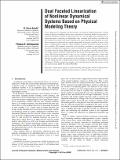| dc.contributor.author | Asada, H. Harry | |
| dc.contributor.author | Sotiropoulos, Filippos Edward | |
| dc.date.accessioned | 2020-07-10T16:18:37Z | |
| dc.date.available | 2020-07-10T16:18:37Z | |
| dc.date.issued | 2018-10 | |
| dc.date.submitted | 2018-08 | |
| dc.identifier.issn | 1528-9028 | |
| dc.identifier.uri | https://hdl.handle.net/1721.1/126131 | |
| dc.description.abstract | A new approach to modeling and linearization of nonlinear lumped-parameter systems based on physical modeling theory and a data-driven statistical method is presented. A nonlinear dynamical system is represented with two sets of differential equations in an augmented space consisting of independent state variables and auxiliary variables that are nonlinearly related to the state variables. It is shown that the state equation of a nonlinear dynamical system having a bond graph model of integral causality is linear, if the space is augmented by using the output variables of all the nonlinear elements as auxiliary variables. The dynamic transition of the auxiliary variables is investigated as the second set of differential equations, which is linearized by using statistical linearization. It is shown that the linear differential equations of the auxiliary variables inform behaviors of the original nonlinear system that the first set of state equations alone cannot represent. The linearization based on the two sets of linear state equations, termed dual faceted linearization (DFL), can capture diverse facets of the nonlinear dynamics and, thereby, provide a richer representation of the nonlinear system. The two state equations are also integrated into a single latent model consisting of all significant modes with no collinearity. Finally, numerical examples verify and demonstrate the effectiveness of the new methodology. ©2019 by ASME. | en_US |
| dc.description.sponsorship | NSF, Science and Technology Center - STC & Emergent Behaviors in Integrated Cellular Systems -EBICS (Grant CBET-0939511) | en_US |
| dc.description.sponsorship | National Research Foundation Singapore through the Singapore MIT Alliance for Research and Technology’s Bio-SyM IRG Research Program. | en_US |
| dc.description.sponsorship | Komatsu, Ltd. | en_US |
| dc.description.sponsorship | Ford Foundation | en_US |
| dc.language.iso | en | |
| dc.publisher | ASME International | en_US |
| dc.relation.isversionof | https://dx.doi.org/10.1115/1.4041448 | en_US |
| dc.rights | Article is made available in accordance with the publisher's policy and may be subject to US copyright law. Please refer to the publisher's site for terms of use. | en_US |
| dc.source | ASME | en_US |
| dc.title | Dual faceted linearization of nonlinear dynamical systems based on physical modeling theory | en_US |
| dc.type | Article | en_US |
| dc.identifier.citation | Asada, H. Harry and Filippos E. Sotiropoulos, "Dual Faceted Linearization of Nonlinear Dynamical Systems Based on Physical Modeling Theory." Journal of Dynamic Systems, Measurement, and Control 141, 2 (February 2019): no. 021002 doi. 10.1115/1.4041448 ©2019 Authors | en_US |
| dc.contributor.department | Massachusetts Institute of Technology. Department of Mechanical Engineering | en_US |
| dc.relation.journal | Journal of Dynamic Systems, Measurement and Control, Transactions of the ASME | en_US |
| dc.eprint.version | Final published version | en_US |
| dc.type.uri | http://purl.org/eprint/type/JournalArticle | en_US |
| eprint.status | http://purl.org/eprint/status/PeerReviewed | en_US |
| dc.date.updated | 2020-06-22T13:39:42Z | |
| dspace.date.submission | 2020-06-22T13:39:44Z | |
| mit.journal.volume | 141 | en_US |
| mit.journal.issue | 2 | en_US |
| mit.license | PUBLISHER_POLICY | |
| mit.metadata.status | Complete | |
